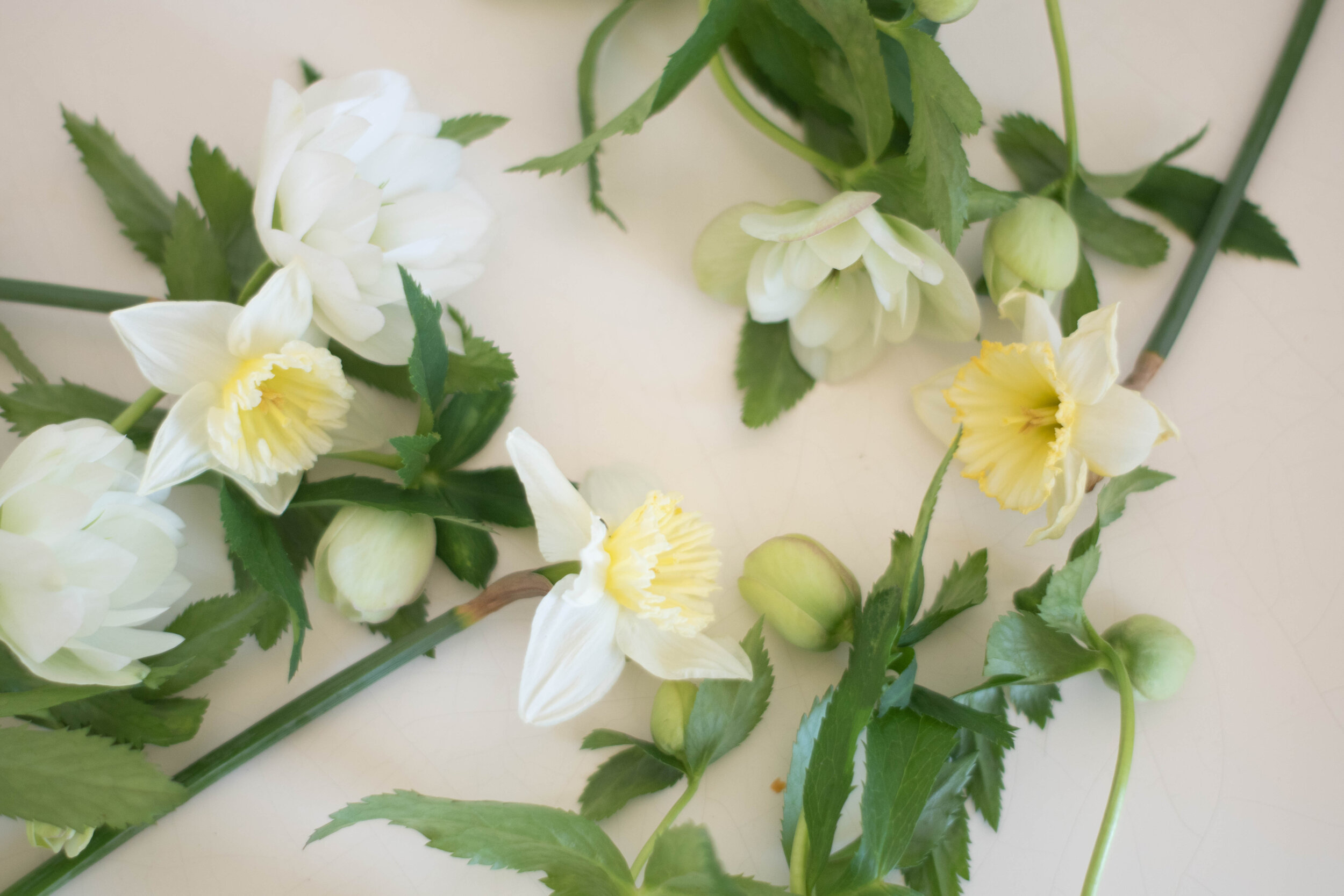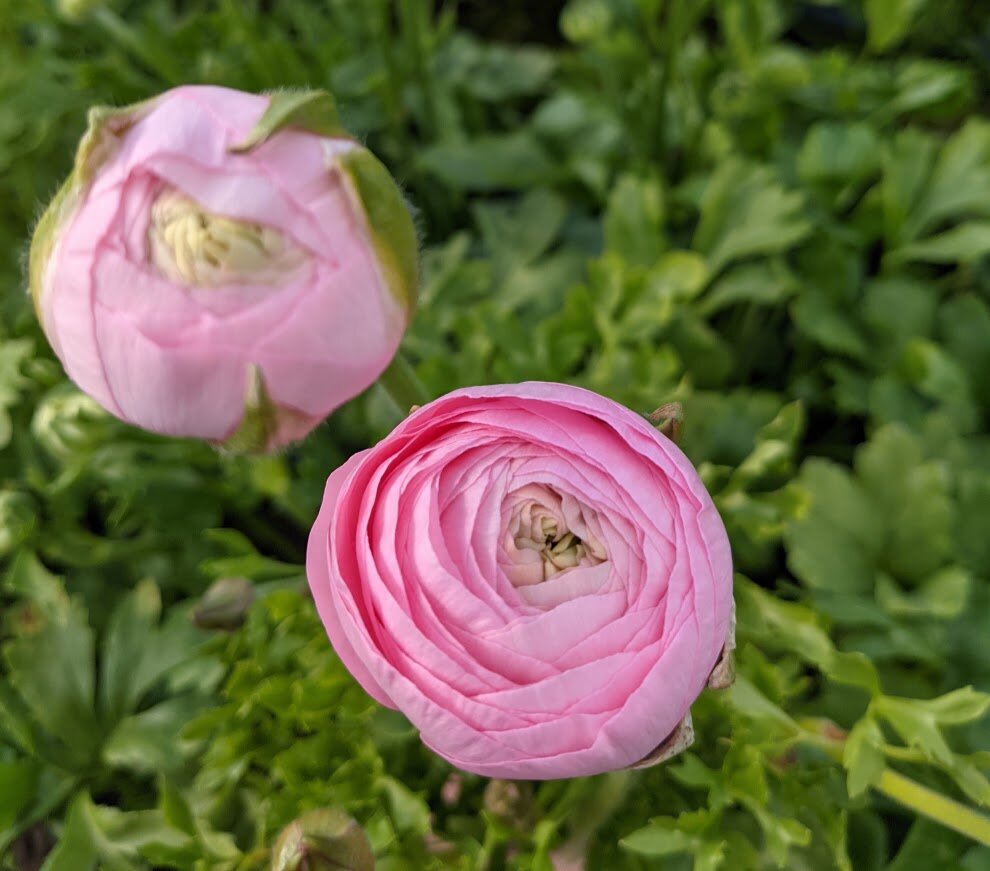How to Harvest and Arrange Your Spring Blooms
Fortunately, for those of us who are beyond ready for the beauty of summer gardens, there are many flowers which bloom despite the chilly weather in spring. Although I want to enjoy them it can still be too cold to spend much time outdoors admiring them so I usually bring a few indoors. My favorites include tulips, daffodils, hyacinth, grape hyacinth, anemone, ranunculus, hellebore, and peony. Each is a unique plant requiring equally unique harvesting techniques.
Tulips are the most common spring bloom to bring indoors with their diverse colors, textures and graceful stems adding flare to floral arrangements. Tulips can be harvested 2 different ways depending on your ultimate goal. 1) If you want the longest stem, and vase-life I would suggest pulling the stem with the bulb attached, 2) If you want the tulips to multiply and naturalize in your yard then I would suggest cutting the tulip very short and leaving the foliage. My caution with the second harvesting tip is you will have very short stems and tulips have a tendency to produce more stems for a few years but will eventually die-back and produce very few stems.
Harvest: When flowers are not open yet but are just coloring up
How: Cut stem at base or pull the bulb from the soil and cut the stem just above the bulb
Vase-life: 7-10 days but lasts a bit longer with flower food
Daffodils are a bright delight in the garden and come in a range of color and texture combinations with yellow, white, coral, peach, and orange. Daffodils are easy to harvest by pulling the stems with your hand until they pop from their base. Where gloves since the sap from daffodils can be toxic and irritate your skin. After harvesting, leave stems in water for 6-12 hours until the end of the stem seals up a bit. If you arrange flowers before the stem has sealed up then it can decrease the vase-life of other flowers in the vase.
Harvest: When flowers are just starting to open up and the petals are somewhat loose
How: Cut stems at base or tug by grabbing the base of the stem
Vase-life: 7-10 days but lasts a bit longer with flower food
Hyacinth stems are typically on the short side but are a densely covered flower coming in jewel and pastel tones. Stems are typically on the short side and can wilt easily after harvesting. I would suggest using this flower in short arrangements. You can harvest flowers and put them in a vase with the bulb attached for the longest vase-life. Wear gloves when working with this flower as hyacinths have toxic sap for the skin.
Harvest: After all of the buds are colored without green and a few flowers have opened up
How: Cut stems at base or tug by grabbing the base of the stem removing the bulb too
Vase-life: 5-10 days
Grape Hyacinth really does look like a bundle of grapes and comes in a range of purple grapey hues. They may be the shortest stems of the spring blooms but are a delightful addition to petite flower arrangements. Despite the common name of Grape Hyacinth they are actually a lily so despite the common name they aren’t toxic and are actually edible with a hint of earthy grape flavor.
Harvest: When bottom flowers are beginning to open with a slight white edge
How: Cut stems at the base or tug gently from the plant by grabbing the bottom of the stem
Vase-life: 7-10 days
Anemone flowers come in a gorgeous range of jewel and pearly white tones and are accented with a dark blue-violet center. Flowers are delicate and are best harvested when the petals are starting to open slightly. Cut the stems at the base near the soil leaving other side stems and leaves on the plant to produce more flowers throughout the year. Plants typically produce 15-20 flowers in the year before temperatures start to warm up beyond 80F.
Harvest: When petals are just starting to open up
How: Cut stems at base leaving foliage and side stems
Vase-life: 5-8 days but lasts a bit longer with flower food
Ranunculus are ruffled beauties coming in a range of colors and the more they unfurl the more delicately fluffy they appear. It is best to harvest flowers when the petals start to color up and just before they unfurl. Cut the stems at the base near the soil leaving other side stems and leaves on the plant to produce more flowers throughout the year. Plants typically produce 5-10 flowers in the year before temperatures start to warm up beyond 80F.
Harvest: When the flower has colored up and is barely starting to unfurl
How: Cut stems at base or tug by grabbing the base of the stem
Vase-life: 10-12 days but lasts a bit longer with flower food
Hellebore often bloom in late-winter or early-spring and have multiple flowers held on each stem. Harvest when at least one of the blooms on each stem has lost the bright yellow inner petals and all that remains are the pointed centers and outer petals (which are actually sepals, shown in the picture to the right). Harvest flower stems at the base near the soil surface, place in boiling water for 5 seconds and slice up the sides of the stem a few inches just cutting through the outer tissue to improve water uptake.
Harvest: When yellow petal centers have fallen out and just the spiked green center remains
How: Cut stems at base or tug by grabbing the base of the stem
Vase-life: 14-21 days if you harvest at the right stage, boil and cut the stem, just a few days without using those techniques
Pansies come in a variety of colors and sizes and are delightful to use in arrangements. If you are using them in floral arrangements I recommend harvesting them just as they open up as they are a delight to watch unfurl. Since pansies are typically on the short side I would suggest types that are taller to achieve the longest stems for arranging. The large flower heads tend to flop a bit so I would recommend using other flowers to help support them and keep their bright little faces upward.
Harvest: When flowers are just beginning to open up
How: Cut stems as low as possible but leave foliage and lower side stems on the plant to continue to produce flowers
Vase-life: 5-7 days but lasts longer with flower food
Although all of these flowers are delightful in their own arrangements, wide mouth vases don’t provide enough support to a few stems so they often droop to the side.
In arrangements like these a flower frog is your best friend! Flower frogs come in a variety of shapes and sizes depending on your arrangement and vase. You simply set the frog in the base of the vase and push the stems onto the many upward facing pins on the frog.
Here is a close up of larkspur stems in a flower frog without the vase so you can see it in action. You can see the stems are nestled and pressed into the pins allowing the flower stems to gracefully branch away from each other.
With the addition of a flower frog you can create interesting and dynamic shapes. This one tool will take your arrangements from backyard bouquet basic to weekend flower stylist. Scroll for more design inspiration using a flower frog with daffodils and hellebore!
Daffodils in a white vase using a flower frog. Cutting stems at different lengths and directing the blossoms in different ways adds interest to this arrangement! Try using a variety of daffodils that will play off each others colors, shapes and textures.
Hellebore flowers often have leaves and other buds attached adding texture and depth to the arrangement. Flowers often dip downwards so arranging with a flower frog keeps the blooms a little more upright. I would also place these on a higher shelf or dresser so you can fully enjoy these flowers that gracefully bow downwards.
After you get the hang of your flower frog and arranging with your blooms start adding them together! I would suggest using complimentary tones that will make even beginner arrangements look well designed. Here you have 2 kinds of daffodils, 1 in bright yellow and 1 in creamy yellow and white tones. The creamy yellow daffodil acts as a bridge between the bright yellow daffodils and the white hellebore tying all of the elements together in this arrangement! You can also forage for some greenery from shrubs to add more texture and color to your arrangements. Enjoy your spring blooms!












